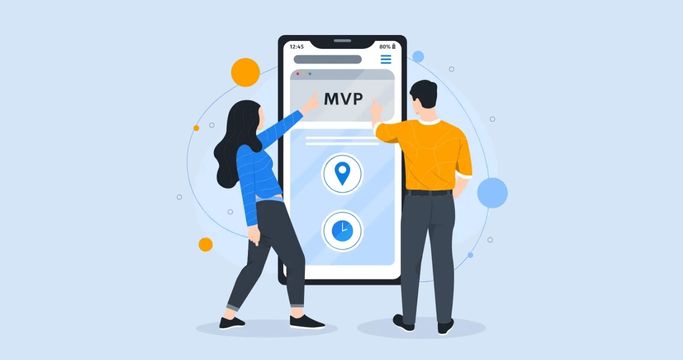It seems like you’ve provided a detailed overview of what an MVP (Minimum Viable Product) is and highlighted its importance, especially for startups. Additionally, you’ve discussed the factors influencing the cost of developing an MVP mobile app, such as the development team, design, geolocation, features, and technology choices.
What is an MVP app?
- A minimum viable product (MVP) is a functional app with essential features.
- It allows for phased feature development, preventing excessive spending.
- Helps in smart spending and data collection for future investment.
- Enables testing, user feedback, and validation of the app’s purpose.
Why you need an MVP mobile app
Creating a Minimum Viable Product (MVP) for a mobile app offers several advantages, providing a strategic approach to app development. Here are some reasons why you might consider developing an MVP:

MVP Development Cost
-
Cost-Efficiency
- Developing a full-featured mobile app can be expensive and time-consuming. An MVP allows you to test the market with a scaled-down version, minimizing initial investment while still delivering core functionalities.
-
Risk Mitigation
- By releasing an MVP, you can assess user feedback and market response before committing to a full-scale development. This helps identify potential issues and necessary adjustments early in the process, reducing the risk of investing heavily in an unsuccessful product.
-
Quick Time-to-Market
- An MVP focuses on the essential features, allowing for a faster development cycle. This rapid deployment helps you enter the market sooner, gaining a competitive edge and enabling quicker responses to user needs and industry changes.
-
User Feedback and Validation
- Launching an MVP enables you to gather valuable feedback from real users. This feedback can guide further development, ensuring that the final product aligns with user expectations and addresses their needs.
-
Iterative Development
- An MVP encourages an iterative development process. Based on user feedback and performance metrics, you can make continuous improvements and additions to the app, evolving it in response to changing market demands.
-
Resource Optimization
- By focusing on the core features in the initial stages, you can optimize resource allocation, both in terms of development efforts and budget. This ensures that resources are directed toward the most crucial aspects of the app.
-
Market Testing
- The MVP allows you to test the market demand for your app. It provides insights into user behavior, preferences, and acceptance, helping you make informed decisions about whether to continue investing in the project.
-
Reduced Time to Pivot
- If the initial concept does not gain traction, an MVP allows you to pivot or change directions quickly. This adaptability is crucial in the dynamic and competitive landscape of mobile app development.
-
Attracting Investors and Partners
- An MVP provides a tangible product to showcase when seeking funding or partnerships. It demonstrates that you’ve taken the first steps, validated the concept, and are ready to scale based on initial success and user feedback.
In summary, developing an MVP for a mobile app is a strategic approach that helps manage costs, reduce risks, and gather valuable insights early in the development process, setting the stage for a more successful and user-oriented final product.
Cost of building an MVP mobile app
Building a Minimum Viable Product (MVP) for a mobile app involves various factors that contribute to the overall cost. As you rightly pointed out, the key determinants include the development team, design complexity, geolocation, features, and technology choices. Let’s break down the estimated costs for different development team options based on your provided information:
-
Outsourcing:
- Estimated cost: $4,000 to $20,000
- Outsourcing is often a cost-effective option, especially if you choose a development team from regions with lower labor costs.
-
In-House:
- Estimated cost: $132,000 to $155,000
- In-house development tends to be more expensive due to higher labor costs and overhead associated with maintaining an internal team.
-
Local Teams:
- Estimated cost: $160,000 to $180,000
- Local teams may offer advantages in terms of communication and collaboration, but the costs can be higher compared to outsourcing.
-
Freelancers:
- Estimated cost: $4,000 to $15,000
- Freelancers can be a cost-effective option for specific tasks or short-term projects, but it’s essential to ensure the quality and reliability of individual freelancers.
Remember, these estimates are generalizations, and actual costs can vary based on the complexity of your app, the expertise of the team, and other project-specific factors. Additionally, the geolocation of the development team plays a significant role in cost differences.
It’s crucial to thoroughly evaluate your project requirements, conduct market research, and choose a development approach that aligns with your budget and goals. Keep in mind that investing in a high-quality MVP can be a strategic move, as it allows you to test your app concept with minimal features before committing to a full-scale development.
Factors influencing MVP development costs
Conclusion
- Determining MVP development cost involves considering crucial factors.
- An MVP is essential for building a successful mobile app.
- Releasing an MVP allows for valuable feedback and necessary improvements.
In summary, building an MVP is a strategic approach for startups, helping them validate their ideas, collect user feedback, and reduce the risk of failure. The cost of developing an MVP depends on various factors, and careful consideration of these factors is crucial for successful and cost-effective MVP development.